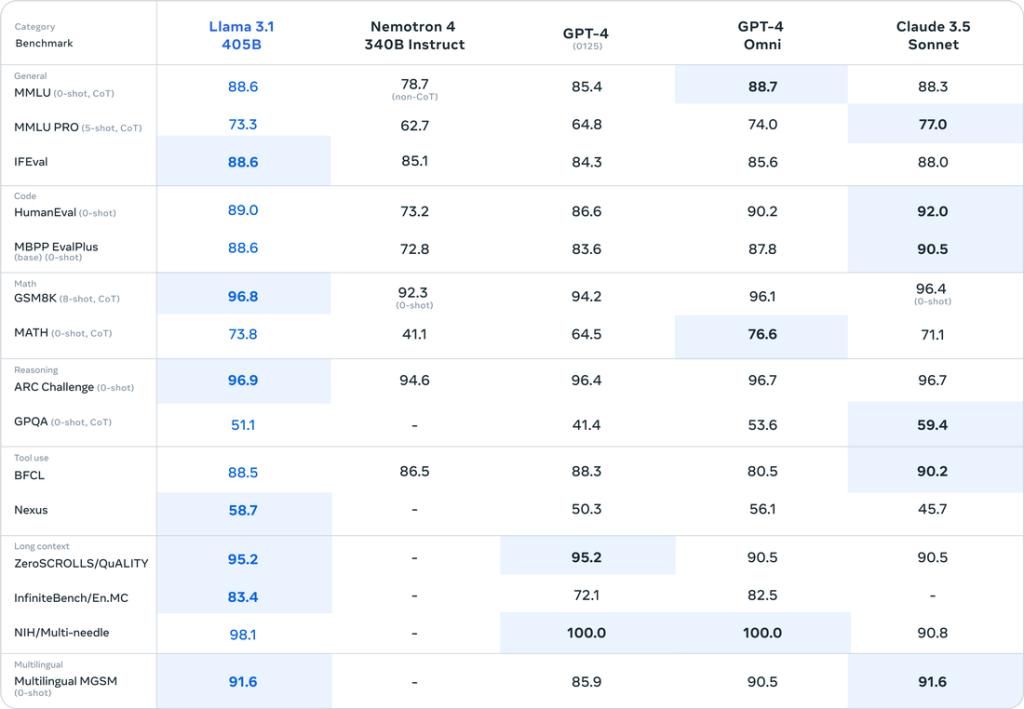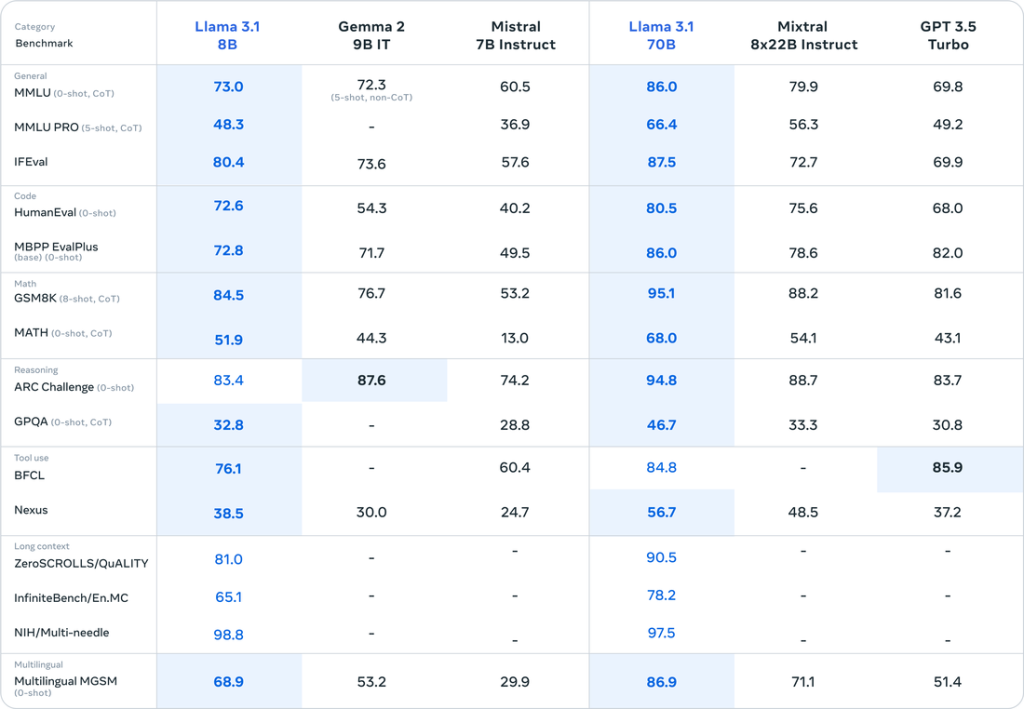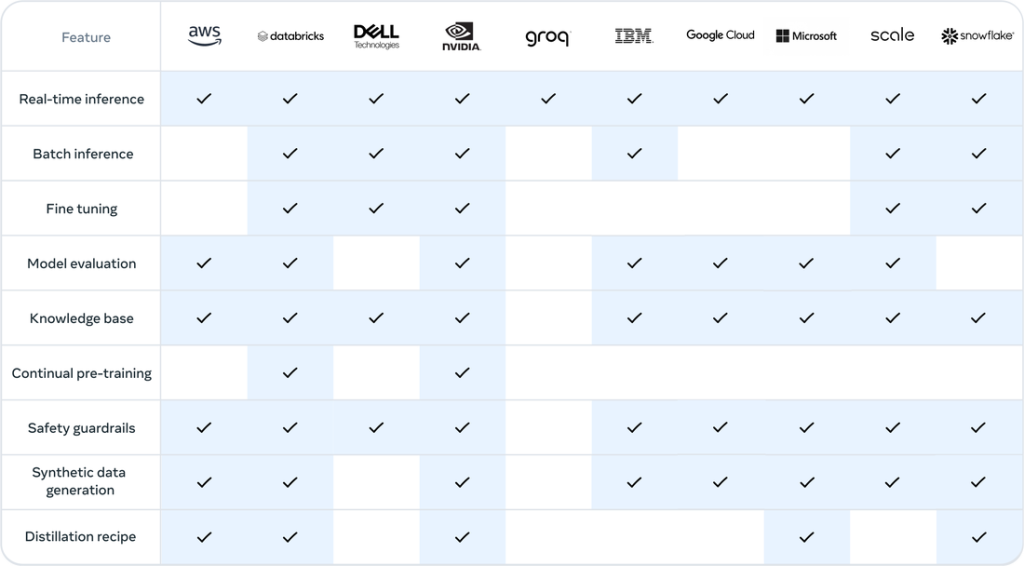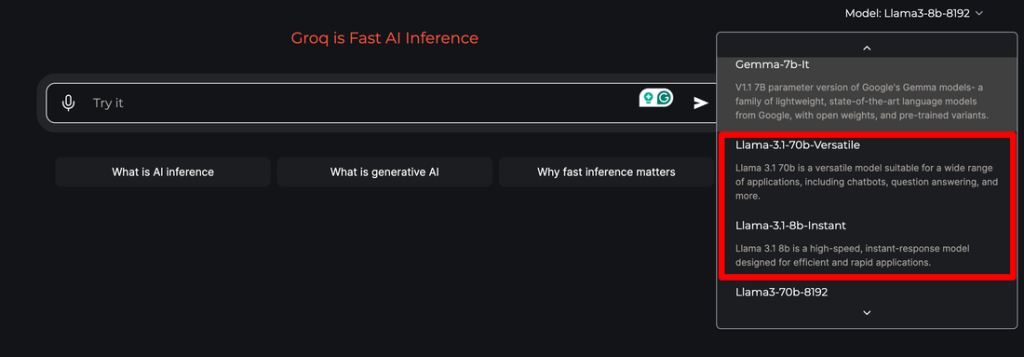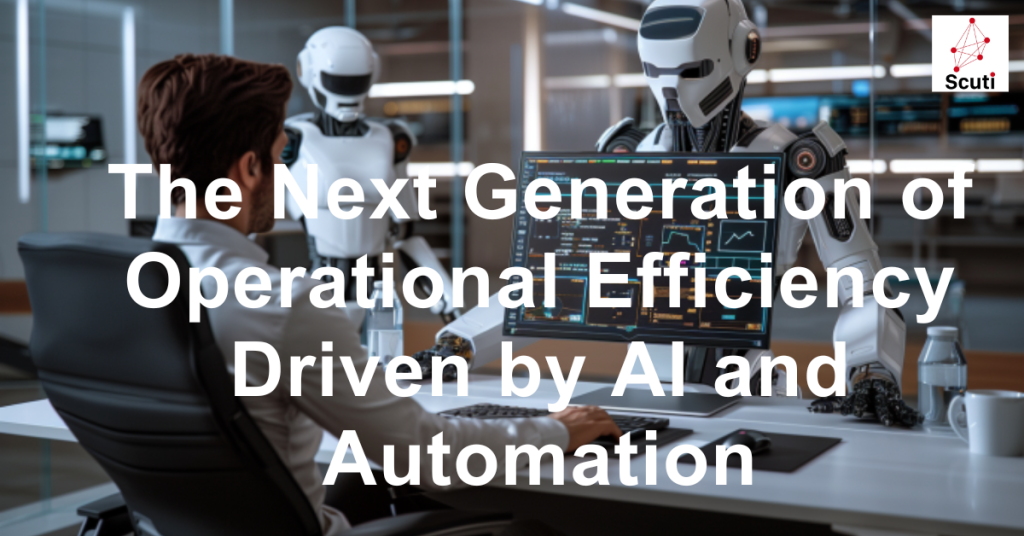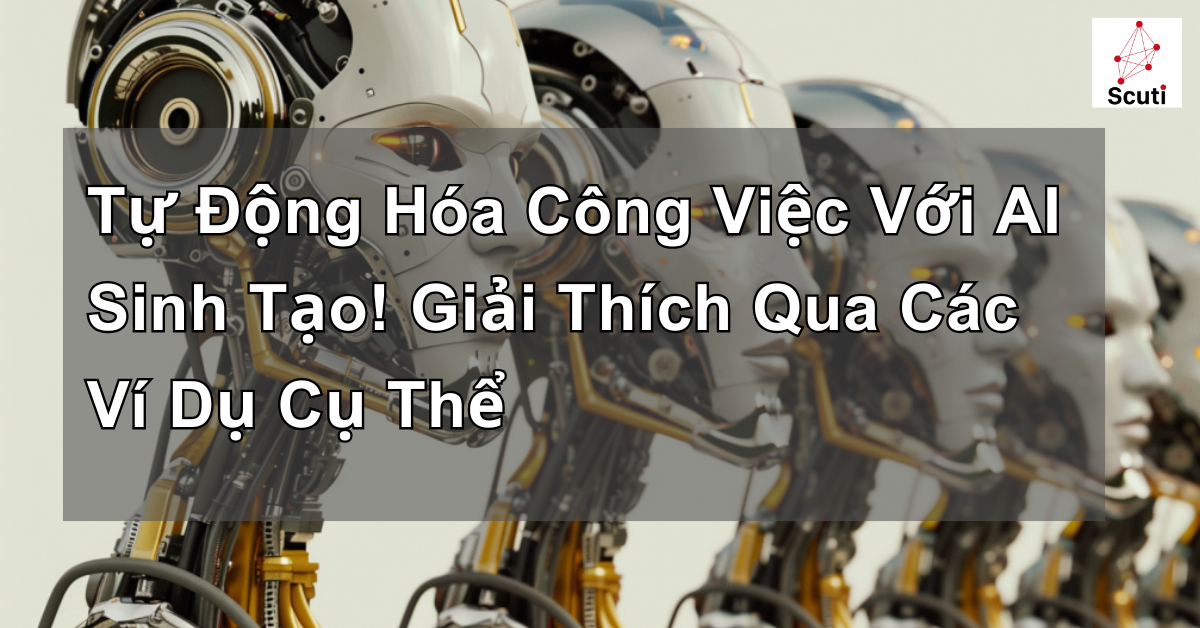
Xin chào, tôi là Kakeya, đại diện của công ty Scuti.
Công ty chúng tôi cung cấp các dịch vụ như phát triển phần mềm offshore và phát triển kiểu lab tại Việt Nam, với thế mạnh về AI tạo sinh, cũng như tư vấn AI tạo sinh. Gần đây, chúng tôi rất may mắn khi nhận được nhiều yêu cầu phát triển hệ thống liên quan đến AI tạo sinh.
Với sự tiến hóa của AI tạo sinh trong những năm gần đây, giờ đây có nhiều lựa chọn hơn cho việc tự động hóa công việc. Để duy trì lợi thế cạnh tranh, việc sử dụng AI tạo sinh là chìa khóa đối với các doanh nghiệp.
Trong bài viết này, chúng tôi sẽ giới thiệu các ví dụ về việc tự động hóa công việc sử dụng AI tạo sinh trong các hoạt động khác nhau và giải thích chi tiết cách thức chúng giúp nâng cao hiệu quả công việc.
Chúng tôi sẽ phân tích từ góc độ thực tế cách mà AI tạo sinh đang biến đổi các quy trình công việc và giảm thiểu thời gian cũng như chi phí. Các ví dụ cụ thể về việc sử dụng AI tạo sinh và sự cải thiện hiệu quả công việc sẽ được chia sẻ.
Ứng Dụng AI Tạo Sinh Để Tự Động Hóa Công Việc

Cải Thiện Hiệu Quả Giao Tiếp Với AI Tạo Sinh
Các hiệu quả cụ thể khi sử dụng AI tạo sinh để cải thiện hiệu quả giao tiếp rất rõ ràng. Bằng cách sử dụng AI tạo sinh, giao tiếp trong công việc hàng ngày trở nên suôn sẻ hơn và việc chia sẻ thông tin trong công ty được đẩy nhanh.
Ví dụ, việc tự động hóa trả lời các câu hỏi giữa các nhân viên sẽ giúp giảm đáng kể thời gian chờ đợi câu trả lời, giúp quy trình công việc diễn ra mà không bị gián đoạn.
Ngoài ra, việc giới thiệu tính năng tóm tắt cuộc họp tự động giúp các thành viên nhanh chóng nắm bắt được các điểm quan trọng trong cuộc họp, từ đó đưa ra quyết định hiệu quả. Những công nghệ này không chỉ nâng cao chất lượng giao tiếp mà còn giảm thiểu chi phí thời gian, góp phần nâng cao năng suất công ty một cách đáng kể.
Các Phương Pháp Tự Động Hóa Quản Lý Dữ Liệu và Phân Tích
Việc sử dụng AI tạo sinh trong tự động hóa quản lý dữ liệu và phân tích đã cải thiện đáng kể hiệu quả công việc.
Bằng cách tự động hóa quá trình trích xuất và tổ chức thông tin cần thiết từ lượng dữ liệu lớn, AI tạo sinh giúp giảm thiểu lỗi do công việc thủ công và rút ngắn thời gian làm việc.
Ví dụ, khi phân tích cơ sở dữ liệu khách hàng để dự báo xu hướng thị trường, AI tạo sinh sử dụng khả năng nhận diện mẫu và học máy để cung cấp thông tin quan trọng một cách hiệu quả. Công nghệ này giúp các doanh nghiệp nhanh chóng đáp ứng với sự thay đổi của thị trường và đưa ra quyết định chiến lược.
Ngoài ra, chức năng tạo báo cáo tự động của AI tạo sinh rất hữu ích cho các nhà lãnh đạo doanh nghiệp trong việc theo dõi tiến độ công việc định kỳ. Điều này giúp việc ra quyết định dựa trên dữ liệu trở nên nhanh chóng và chính xác hơn.
Ví Dụ Tự Động Hóa Trong Hỗ Trợ Khách Hàng
Trong tự động hóa hỗ trợ khách hàng, việc ứng dụng AI tạo sinh đã góp phần trực tiếp vào việc nâng cao sự hài lòng của khách hàng.
Bằng cách sử dụng công nghệ này, có thể trả lời các câu hỏi của khách hàng theo thời gian thực và hoạt động 24/7.
Một ví dụ điển hình là việc triển khai chatbot AI. Những chatbot này có thể trả lời nhanh chóng các câu hỏi của khách hàng dưới dạng hội thoại tự nhiên, cung cấp bước đi đầu tiên hiệu quả trong việc giải quyết vấn đề.
Hơn nữa, qua việc phân tích dữ liệu khách hàng sử dụng AI tạo sinh, doanh nghiệp có thể hiểu được lịch sử mua hàng và sở thích của khách hàng, từ đó cung cấp dịch vụ cá nhân hóa.
Điều này giúp cung cấp hỗ trợ phù hợp cho từng khách hàng, nâng cao sự hài lòng của họ một cách đáng kể.
Ví Dụ Cụ Thể và Hiệu Quả Của AI Tạo Sinh
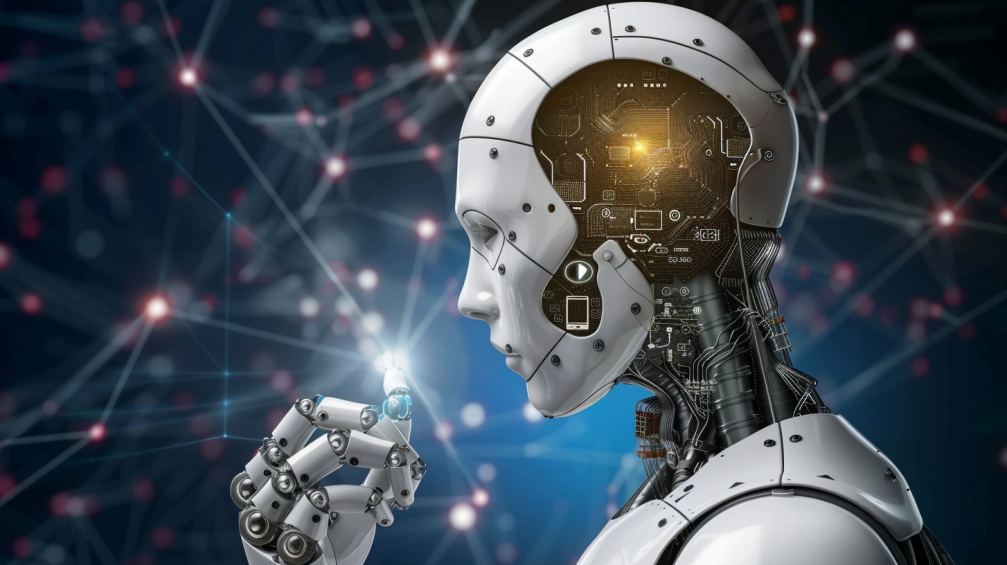
Ứng Dụng Thực Tế của AI Tạo Sinh
Các ví dụ ứng dụng thực tế của AI tạo sinh cho thấy sự đa dạng và hiệu quả rộng lớn của nó. Đặc biệt là trong ngành sản xuất, AI tạo sinh đang được áp dụng ở từng giai đoạn từ thiết kế đến sản xuất.
Ví dụ, một nhà sản xuất ô tô đã sử dụng AI tạo sinh để tối ưu hóa thiết kế bộ phận ô tô, cải thiện tốc độ thử nghiệm một cách đáng kể. Công nghệ này đã giảm bớt công việc lặp lại trong thiết kế, giúp tiết kiệm chi phí và thời gian.
Trong hỗ trợ khách hàng, một hệ thống AI tự động trả lời câu hỏi của khách hàng đã được triển khai, giúp tăng tốc và cải thiện độ chính xác của dịch vụ khách hàng. Điều này đã dẫn đến sự hài lòng của khách hàng tăng lên và độ tin cậy của thương hiệu được cải thiện.
Những ví dụ này chứng minh cách mà AI tạo sinh có thể cải thiện quy trình công việc và tăng cường khả năng cạnh tranh của công ty. Việc triển khai AI tạo sinh không chỉ là một bước tiến về công nghệ mà còn có tiềm năng biến đổi mô hình kinh doanh, và ứng dụng của nó đã chứng minh mang lại kết quả đáng kể.
Ví Dụ Thành Công Của Việc Tăng Cường Hiệu Quả Công Việc Với AI Tạo Sinh
Các ví dụ thành công trong việc tăng cường hiệu quả công việc bằng AI tạo sinh đặc biệt nổi bật trong cả dịch vụ khách hàng và các quy trình nội bộ.
Ví dụ, một tổ chức tài chính đã triển khai một hệ thống AI phân tích các câu hỏi của khách hàng và tạo ra các phản hồi thích hợp. Hệ thống này tự động phân loại các câu hỏi và cung cấp giải pháp tối ưu, giảm thời gian phản hồi xuống 70%.
Ngoài ra, trong việc quản lý tài liệu nội bộ, AI tạo sinh đã được sử dụng để tự động hóa việc phân loại và tổ chức tài liệu, giúp nhân viên có thể tập trung vào các công việc quan trọng hơn. Kết quả là, hiệu quả công việc tổng thể được cải thiện và chi phí vận hành của công ty giảm xuống.
Như vậy, việc áp dụng AI tạo sinh không chỉ tự động hóa các công việc lặp lại mà còn nâng cao chất lượng công việc và tăng cường khả năng cạnh tranh của công ty.
Con Đường Đến Thành Công Khi Triển Khai AI Tạo Sinh

Chiến Lược và Kế Hoạch Cụ Thể Cho Việc Triển Khai AI Tạo Sinh
Chiến lược và kế hoạch cụ thể cho việc triển khai AI tạo sinh là những bước quan trọng hướng tới thành công.
Trước tiên, các công ty cần phân tích chi tiết các quy trình công việc của mình để xác định công việc nào có thể cải thiện hiệu quả nhất thông qua tự động hóa.
Tiếp theo, cần chọn loại AI tạo sinh sẽ triển khai và các chức năng của nó, và lập kế hoạch tích hợp nó vào quy trình công việc thực tế.
Hơn nữa, việc thực hiện các chương trình đào tạo để nâng cao hiểu biết của nhân viên về công nghệ AI là điều cần thiết. Ở giai đoạn này, việc hỗ trợ nhân viên sử dụng các công cụ AI hiệu quả là rất quan trọng để giảm thiểu sự kháng cự đối với công nghệ này.
Ở giai đoạn triển khai, tốt nhất là bắt đầu với một thử nghiệm quy mô nhỏ và dần dần mở rộng hệ thống. Qua quá trình này, các vấn đề bất ngờ có thể được giải quyết nhanh chóng và hệ thống có thể được tối ưu hóa. Cách tiếp cận chiến lược này đảm bảo rằng việc triển khai AI tạo sinh sẽ đóng góp lớn vào việc nâng cao hiệu quả tổ chức và cuối cùng là cho phép vận hành doanh nghiệp cạnh tranh.
Kế Hoạch và Quản Lý Vấn Đề Khi Triển Khai AI Tạo Sinh
Kế hoạch và quản lý vấn đề khi triển khai AI tạo sinh là các yếu tố quan trọng quyết định sự thành công của dự án. Một kế hoạch hiệu quả bắt đầu từ việc đặt mục tiêu.
Cụ thể, cần phải xác định rõ ràng các quy trình công việc nào sẽ được tự động hóa và kết quả mong đợi là gì. Tiếp theo, việc chọn lựa giải pháp AI phù hợp và đảm bảo có đủ dữ liệu và tài nguyên cần thiết là rất quan trọng. Các thách thức chính ở đây là chất lượng dữ liệu, sự dễ dàng tiếp cận và tính tương thích với các hệ thống hiện có.
Một khía cạnh quan trọng trong giai đoạn lập kế hoạch là đảm bảo rằng tất cả các bên liên quan đều hiểu và chia sẻ mục tiêu và kết quả kỳ vọng của dự án. Thông qua việc chia sẻ này, sự hợp tác giữa các nhóm được thúc đẩy và việc giải quyết các vấn đề sẽ được tiến hành nhanh chóng. Ngoài ra, việc xây dựng một kế hoạch quản lý rủi ro và chuẩn bị cho các vấn đề kỹ thuật bất ngờ hoặc các trở ngại trong quá trình triển khai là điều cần thiết. Vì việc triển khai AI tạo sinh thường yêu cầu nhiều điều chỉnh trong quá trình, việc phản ứng linh hoạt có thể là cần thiết.
Cuối cùng, việc thiết lập các cơ hội xem xét và phản hồi định kỳ cho phép giám sát tiến độ của dự án và điều chỉnh kế hoạch khi cần thiết. Điều này sẽ làm tăng khả năng thành công trong việc triển khai AI tạo sinh, từ đó giúp cải thiện hiệu quả công việc và thúc đẩy đổi mới sáng tạo.
Các Công Cụ AI Tạo Sinh Góp Phần Tăng Cường Hiệu Quả Công Việc

Chọn Lựa Công Cụ AI Tạo Sinh Hữu Ích Cho Công Việc
Khi chọn lựa công cụ AI tạo sinh hữu ích cho công việc, có một số điểm quan trọng cần xem xét. Trước hết, cần phải đánh giá công cụ AI được triển khai có thể đáp ứng nhu cầu công việc cụ thể nào. Ví dụ, khi chọn lựa công cụ AI tự động hóa dịch vụ khách hàng, cần tập trung vào khả năng của công cụ trong việc trả lời câu hỏi của khách hàng một cách nhanh chóng và chính xác.
Tiếp theo, cần phân tích cẩn thận chi phí triển khai công cụ và lợi ích mà nó mang lại. Dù công cụ có đắt đỏ nhưng nếu giúp tiết kiệm chi phí dài hạn nhờ việc cải thiện hiệu quả công việc, nó có thể được coi là một khoản đầu tư xứng đáng. Ngoài ra, tính dễ sử dụng của công cụ cũng là tiêu chí quan trọng khi lựa chọn. Nếu công cụ dễ sử dụng, thời gian đào tạo nhân viên sẽ được rút ngắn và năng suất công việc sẽ được cải thiện sau khi triển khai.
Hơn nữa, hệ thống hỗ trợ cũng cần được xem xét. Hỗ trợ kỹ thuật sau khi mua và tần suất cập nhật sẽ ảnh hưởng rất lớn đến tính khả dụng của công cụ. Với sự hỗ trợ thích hợp, các sự cố sau khi triển khai có thể được giải quyết nhanh chóng và các tính năng mới nhất luôn được sử dụng.
Dựa trên những điểm này, việc chọn lựa công cụ AI tạo sinh phù hợp sẽ mang lại sự cải thiện lớn về hiệu quả công việc và trở thành yếu tố quan trọng giúp tăng cường khả năng cạnh tranh của công ty.
Giảm Chi Phí và Tăng ROI Với Công Cụ AI Tạo Sinh
Việc giảm chi phí và tăng ROI (Lợi tức đầu tư) thông qua công cụ AI tạo sinh mang lại lợi ích lớn cho các doanh nghiệp.
Việc triển khai công cụ AI giúp giảm bớt nguồn nhân lực và rút ngắn thời gian làm việc, từ đó dẫn đến việc giảm chi phí trực tiếp.
Ví dụ, khi triển khai chatbot AI trong các phòng ban dịch vụ khách hàng, không còn cần thêm nhân sự để xử lý lượng lớn yêu cầu của khách hàng, và nhân viên hiện tại có thể đảm nhận công việc này. Điều này không chỉ giúp giảm chi phí nhân công mà còn làm giảm bớt gánh nặng công việc của nhân viên, giúp họ tập trung vào các công việc chiến lược hơn.
Hơn nữa, công cụ AI tạo sinh giúp nâng cao độ chính xác trong việc xử lý và phân tích dữ liệu, từ đó nâng cao chất lượng quyết định. Việc phân tích dữ liệu chính xác giúp doanh nghiệp nhanh chóng nắm bắt xu hướng thị trường và nhu cầu của người tiêu dùng, từ đó cải tiến sản phẩm và dịch vụ, điều này trực tiếp giúp tăng doanh thu.
Những lợi ích này thường vượt quá khoản đầu tư ban đầu vào công cụ AI, và trong dài hạn, chúng thường mang lại ROI rất cao. Để tối đa hóa hiệu quả đầu tư, cần phải lựa chọn công cụ phù hợp và tiến hành đánh giá, điều chỉnh liên tục. Thông qua những nỗ lực này, công cụ AI tạo sinh không chỉ là một phương tiện giảm chi phí mà còn là một khoản đầu tư chiến lược mạnh mẽ giúp nâng cao khả năng sinh lợi của công ty.






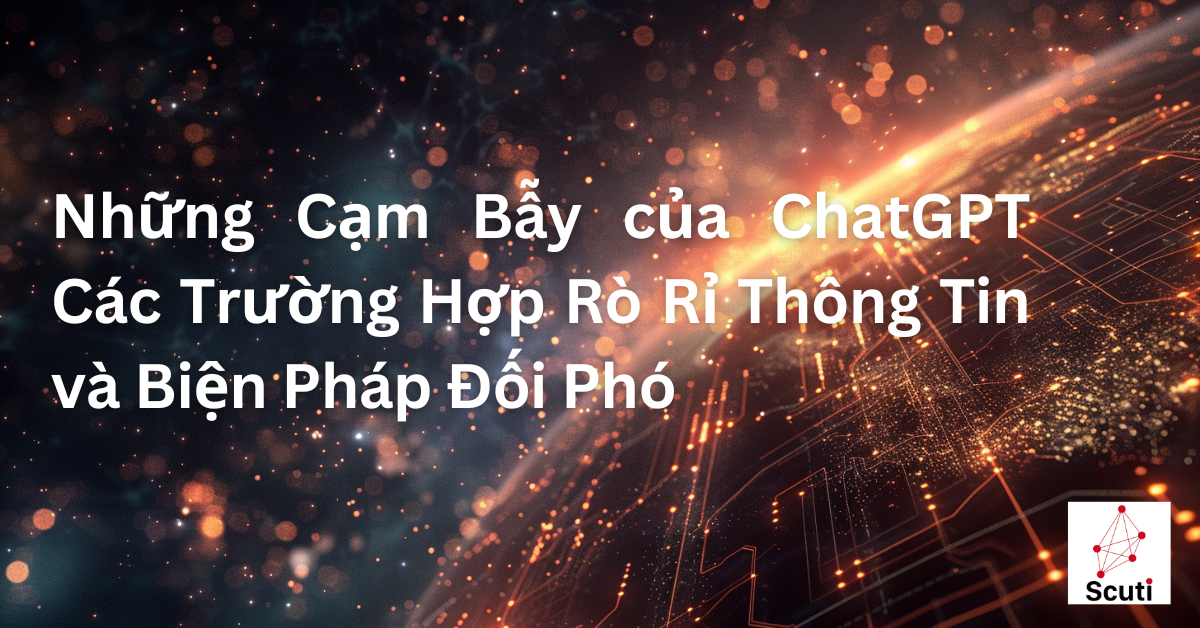
![Streamlining Operations with Generative AI! 10 Business Case Studies [Latest 2024]](https://scuti.asia/wp-content/uploads/2024/11/マーケティング業界-17.png)




![Tối ưu hóa công việc với AI tạo sinh! 10 Ví dụ điển hình trong kinh doanh [Mới nhất 2024]](https://scuti.asia/wp-content/uploads/2024/11/マーケティング業界-15.png)


